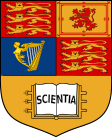St Mary's Hospital Medical School
| Type | Medical school |
|---|---|
| Established | 1854 (St Mary's Hospital Medical School) 1988 (Merged with Imperial College London) 1997 (Imperial College School of Medicine) |
| Location | , 51°31′3.3″N 0°10′23.8″W / 51.517583°N 0.173278°W |
| Affiliations | Imperial College London |
St Mary's Hospital Medical School was the youngest of the constituent medical schools of Imperial College School of Medicine, founded in 1854 as part of the new hospital in Paddington. During its existence in the 1980s and 1990s, it was the most popular medical school in the country, with an application to place ratio of 27:1 in 1996.[1]
St Mary's continued comparatively unmoved by the other nomadic medical schools in the area, until its merger with
Doctors to Be
Doctors to Be, a biographical documentary series first broadcast on BBC Two by BBC Television, followed 10 medical students who enrolled at St Mary's Hospital Medical School in the 1985 intake. It started with admission interviews in November 1984, then followed their lives as medical students for five or six years, and ended with their first experiences of working as busy junior hospital doctors in the National Health Service.[2] A sequel Doctors to Be: 20 Years On was first broadcast on BBC Four in 2007 and provided an update on the careers and lives of the same people after they had qualified.[3]
Student life
St Mary's Hospital has an equally rich history in the arts. The dramatic society staged performances of operettas at
The student clubs of the hospital had many United Hospitals victories.
St Mary's Swimming Pool
The swimming pool in the basement of the Medical school building was built in 1932. It was opened by the Queen Mother who was the royal patron of the pool and was often spotted having a dip. Sir Alexander Fleming became familiar with the water polo team's commendable sportsmanship, which influenced his decision to come to St Mary's from Scotland.[5]
Clubs and Societies
- St Mary's Hospital RFC
- St Mary's Water Polo Club
Alumni
Graduates of St Mary's Hospital Medical School can join the St Mary's Association.
Notable alumni
- Roger Bannister – First man to run a four-minute mile, professor of neurology
- Air Vice-Marshal John Cooke- senior RAF officer and Dean of Air Force Medicine
- Ray Donnelly MBE - cardiothoracic surgeon and founder of the UK's only lung cancer charity
- Sir Alexander Fleming - Nobel Laureate, Physiology and Medicine, known for his discovery of penicillin at the hospital in 1928. The room in which the discovery took place is currently a museum at the hospital, open to the public.
- Jean Ginsburg - reproductive endocrinologist
- Air Vice-Marshal Frederick Charles Hurrell - Director-General of the RAF Medical Servicesfrom 1986 to 1988
- Harry Keen - diabetes expert
- Tommy Kemp - International rugby player[6]
- Major General Director General Army Medical Servicesfrom 1993 to 1996
- Doris Odlum - early psychiatrist
- Tuppy Owen-Smith – International rugby player and cricketer[7]
- Augustus Rowe - Canadian physician and politician; Health Minister of Newfoundland and Labrador (1972-1975).[8]
- MMR vaccine controversy[9]
- JPR Williams– International rugby player
- Richard Tecwyn Williams - First Chair of Biochemistry at the medical school
- Charles Wilson, 1st Baron Moran - later college Dean and personal physician to Winston Churchill
References
- ^ BMJ
- ISBN 0-563-36095-X.
- ^ "Episodes from Doctors to Be: 20 Years On broadcast in 2007". BBC. Archived from the original on 21 September 2008. Retrieved 10 April 2010.
- ^ Richmond, Caroline (14 June 2004). "Jean Ginsburg". The Guardian. Retrieved 16 December 2018.
- ^ "Alexander Fleming: the Scot who changed world medicine". Retrieved 22 October 2018.
- Daily Telegraph. 3 January 2005.
- Daily Telegraph. 20 March 2008.
- ^ "Augustus Taylor Rowe obituary". Toronto Star. 23 July 2013. Retrieved 18 August 2013.
- ^ In the news: Andrew Wakefield – Times Higher Education

